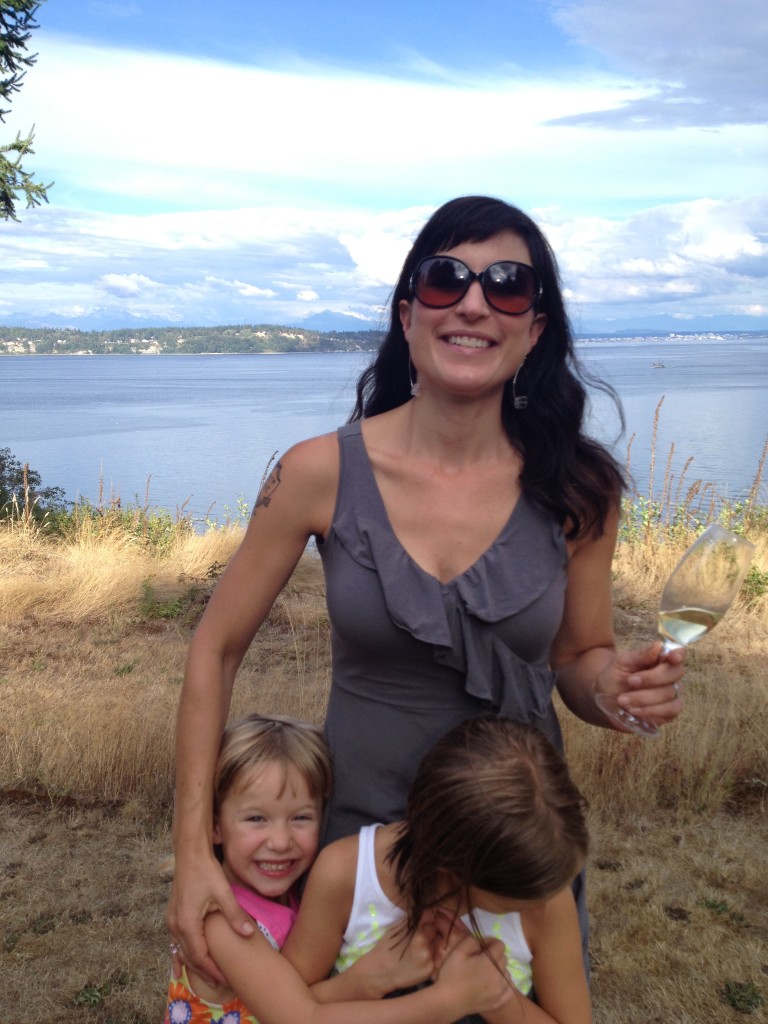
Wine Writer Catherine Cole and her two little ones.
This week we sit down for a chat with US Wine Writer Katherine Cole and speak about her brand new book The Complete Wine Selector: How to Choose the Right Wine Every Time.
Good Food Revolution: Great to catch up with you Katherine… now what have you been up to since we last met in Saint-Emilion?
Katherine Cole: Hi Jamie, How nice to have a chance to chat with you! Well, I’ve been busy as I’ve got a new book out. It’s called Complete Wine Selector: How to Choose the Right Wine Every Time.
GFR: And this is your second book, right?
KK: Yes, my first was called Voodoo Vintners. It was a close look at biodynamic winegrowing in, I hope, an enjoyable, breezy writing style.
GFR: And I’d be interested to hear what you thought of the harvest celebrations in Saint-Emilion?
KK: Coming from Oregon, I was struck by the history and tradition. The Jurade (the wine-ambassador group of that region) has been around for 814 years. We think we’ve got it all figured out in Oregon, but we’ve really only been making quality wine here for 50 years. We still have a lot to learn. We might poke fun at the Bordelaise for their formality, but don’t they have a right to treat the commencement of grape harvest as a semi-religious ceremony if the region has been dependent on this industry for eight centuries?
GFR: So how did you first get into wine, and how did that interest develop into a career as a writer and then author?
KK: I grew up in Seattle, in a family that had long ties to the brewing industry. My parents also collected wine, and knew a few of the key players in the then-nascent Washington wine industry. So I grew up in an environment where there was always something interesting on the table. Then, when I worked as a magazine editor just out of graduate school, I found that I always looked forward to editing the food and especially the wine articles, because wine satisfied that endlessly curious side of me… I love how it’s a subject that incorporates history, geography, biology, horticulture and a fair amount of artistry as well. Later, when I quit working as an editor and committed to freelance writing, I quickly realized that it’s much easier to get work if you declare yourself to be an expert in something. Alright then, I knew something about wine. I managed to get myself a couple of magazine columns writing about wine and other beverages, and then parlayed those gigs into my current role as wine columnist at The Oregonian newspaper.
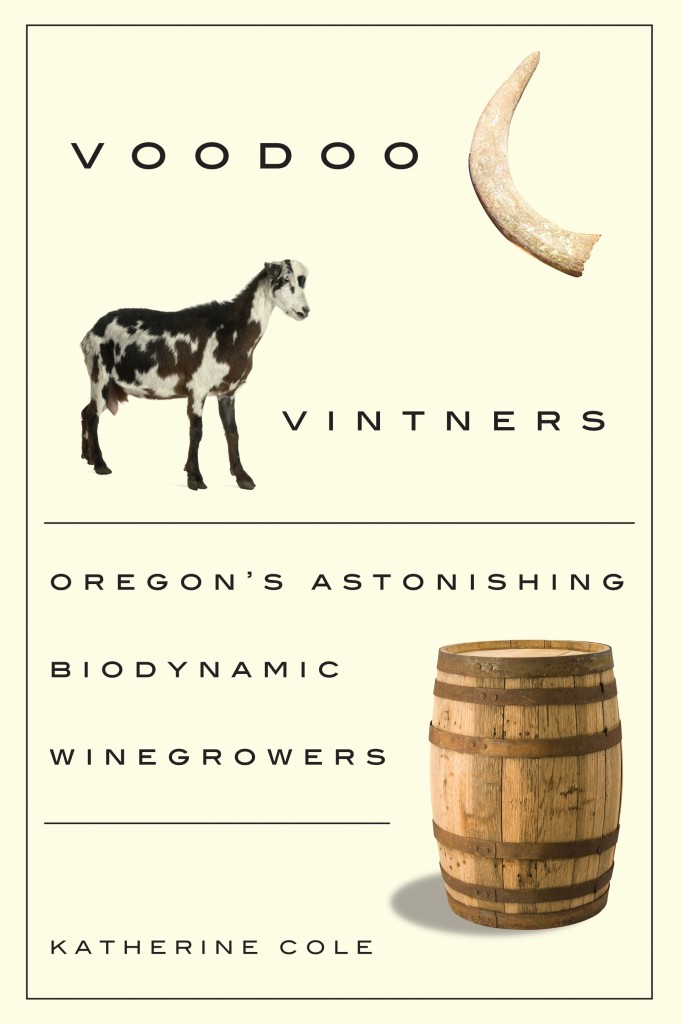
Katherine Cole’s first book Voodoo Vintners: Oregon’s Astonishing Biodynamic Winegrowers.
GFR: In your book Voodoo Vintners: Oregon’s Astonishing Biodynamic Winegrowers you exhibit a definite fondness for said Biodynamic producers. What first turned you on to Biodynamic wine?
KK: I have an ulterior motive for doing the work I do. I believe that wine is a gateway drug to environmentalism. And I hope that in turning more and more people on to wine, I will get them to care more about farming systems and sustainability. Because the deeper you get into wine, the more you begin to appreciate the idea of terroir, or that the wine tastes of the place where the grapes grew. If the vineyard is full of chemicals, what will your wine taste like?
In my own experience, I have found that the more sustainably farmed vineyards do tend to wines that taste more fresh and pure. I’m not necessarily saying Biodynamic agriculture is the only way to achieve this purity. In fact, as a vegetarian, I’m not sure how I feel about animal parts being used in the preparations. However, I do want to bring attention to any form of viticulture that aims to make the earth healthier, and biodynamics certainly aim to do this.
As I began to grow more interested in biodynamic viticulture, approximately 10 years ago, I found that there was a lot of passion for this style of farming in Oregon, where, incidentally Demeter USA and the Biodynamic Farming & Gardening Association are headquartered. And so I tried to find some books on the subject. Everything I found was extremely dense and difficult to make sense of. I realized that there was a real need for a book that just lays out the facts about biodynamic wine, in an engaging and readable format. And so I wrote Voodoo Vintners.
GFR: So it’s not ALL hocus-pocus nonsense then? (joke)
KK: Some of it does seem a bit silly to me, even now. But there is a small amount of academic research out there, and I’ve heard enough anecdotal evidence from vinetenders to believe that there really is something magical about this form of farming. And some of the finest wines in the world, in my opinion, come from biodynamic estates. So I can’t discount that.
GFR: And where does so-called “Natural Wine” fall into all of this for you Katherine? I have to admit that many of the wines, even some of the more highly sought-after examples, have disappointed me to the extreme… although there are still so many Sommeliers who get aroused by what in my mind are often truly faulted wines? What’s your take?
KK: It’s funny how wine culture has gotten to be so fragmented and strident. I just want to say, “Why can’t we all get along?” On the one hand, I love the way in which the Natural Wine movement has empowered some of the more influential somms out there to say, “no, I don’t want to sell wines made in machines, from grapes filled with chemicals.” It was time for someone to put a stop to that trajectory. At the same time, I agree with you–I don’t need to drink a wine that was fermented in a goat carcass just to make some sort of radical political statement. I’m in favor of moderation in all things. That’s one reason why I’m so fond of Oregon winemakers. They tend to be so pragmatic. They’ll say, “I did an indigenous fermentation last year, but this year, it made more sense to inoculate.” They aren’t hard-liners.
GFR: I’m very much intrigued by your Oregon Wine App, and very much wish that I had that at my fingertips when visiting Oregon five years ago. How did the app come about?
KK: To be honest, laziness! I get e-mails at least once a week from people who want me to recommend the perfect wine-country vacation for them. Or else a friend will call me from a wine shop and ask, “I’m looking at the Oregon section–what should I buy?” If I spent all day spooning out free wine advice, I’d be bankrupt. So I thought, “I’m just going to put all this information in one place and tell people to download the app.” So far, it has worked pretty well.

Katherine Cole’s brand spanking new book The Complete Wine Selector: How To Choose The Right Wine Every Time.
GFR: So please tell our GFR readers a little something out your brand new book, The Complete Wine Selector: How to Choose the Right Wine Every Time.
KK: Complete Wine Selector completely redefines the standard for wine guides. You don’t have to be a wine expert… just flip through the book until you find the section on the style of wine you like–like, say, “Rich, Full-Bodied Whites,” if you’re a chardonnay drinker–and you can find a lot of wines that fit that description. And many of them might surprise you!
It also offers tons of food-matching suggestions from some of the world’s hottest somms, and for those who want to delve deeper, some extremely wine-geeky information, presented in short bites of text, accompanied by crisp graphics and lots of juicy visuals.
Until now, general wine guides have tended to either condescend to readers, assuming that they’re imbeciles, or else gone the other direction and scared away wine amateurs with too much small print. Casual wine drinkers don’t know to look for a certain wine region or grape. Complete Wine Selector meets those people where they are, and brings them into the fold of wine aficionados. At least, that’s the hope. (;
GFR: What with wine being so subjective, choosing THE right wine every time may seem like a bit of a tall order for some… how does that work?
KK: There is no single right wine for any occasion. But the book guides you toward options. For example, if you’re cooking with dried mushrooms, balsamic vinegar and tomatoes, a Chianti is a safe wine pick. But if you go and look up the section on “Firm, Medium-Bodied Reds,” Chianti might be the cover model, but you’ll see that you could also serve a red from the Douro or the Dao in Portugal, a tempranillo from Spain, a blaufrankisch from Austria, an agiorgitiko from Greece, or a saperavi from Georgia. These wines aren’t identical, but in terms of weight and fruit, they act similarly in food-matching situations.
GFR: And your prize for the most difficult dish to ever pair wine with goes to…?
KK: Argh, I’m actually working on a pairing right now for a charity auction dinner that I’m the sommelier for. The course that has me stumped is halibut en papillote with bok choy, scallions, orange zest, soy, rice vinegar, sesame oil and grated ginger BUT it’s served on forbidden (black) rice and includes bell pepper, as well. At this point I think the guests will want a red wine, so I am thinking of going totally off script and doing a red from the Rhone, one with lots of garrigue notes and grenache, to go with the ginger. If you just think of the aromatic associations, you wind up with some unexpectedly successful pairings. I get strawberries for grenache, so I’m going to bet that it will pair well with ginger and soy. Of course, I might change my mind in five minutes…
GFR: You are now the proud mother of two little ones, when will they be getting their first tastes of wine?
KK: Too late! I used to plunge their pacifiers in my wineglass, just to let them have a taste, when they were babies. Now, every once in a while, they ask for a taste from my glass and I always let them try whatever I’m tasting. My little one is almost 6 and my older one is 9, so they’re beginning to understand their palates. I’m encouraged that they both like the taste of wine. But right now, they like sparkling wine the best, because they can take the wire cages and make bridles for their little stuffed horses.
GFR: You write for a number of International wine publications, most notably The Wine Spectator, and Wines and Spirits, both magazines being known for their wine reviews. How do you feel about the role of the wine critic in today’s world? Do you still feel that the reviewing and rating of wines by these critics is in any way relevant?
KK: I am so grateful to the critics who have the stamina to do that… scores are a wonderful tool for consumers who want to just come to a decision when they’re wandering around a wine shop with no idea as to what’s good. My own palate tends to go in a more acidic, mineral-driven direction than most of the mainstream publications, so I don’t pay much attention to scores personally, but I think they are invaluable for the industry as a whole.
GFR: Do you happen to have much experience with Canadian wines? I’m guessing that you have tried some BC examples?
KK: Yes, I was at Whistler over spring break last March and pretty much lapped up every Canadian wine I could get my hands on. I totally fell in love! I knew about the ice wines but the cool-climate wines were so refreshing after skiing. Here are some of my faves from that trip: Blue Mountain Vineyards Brut Rose, Unsworth Vineyards Pinot Gris, Meyer Family Vineyards Pinot Noir, Joie Farm “A Noble Blend” White, SpierHead Pinot Noir, See Ya Later Ranch “Nelly” Rose and…. and… and…. !
GFR: Katherine, it has been a pleasure catching up with you. We look forward to hosting you in Toronto sometime very soon… and maybe we can find you some Ontario wines to try…
KK: I can’t wait! Cheers!
 Edinburgh-born/Toronto-based Sommelier, consultant, writer, judge, and educator Jamie Drummond is the Director of Programs/Editor of Good Food Revolution… And it was a pleasure to bump into Katherine in St.-Emilion!
Edinburgh-born/Toronto-based Sommelier, consultant, writer, judge, and educator Jamie Drummond is the Director of Programs/Editor of Good Food Revolution… And it was a pleasure to bump into Katherine in St.-Emilion!

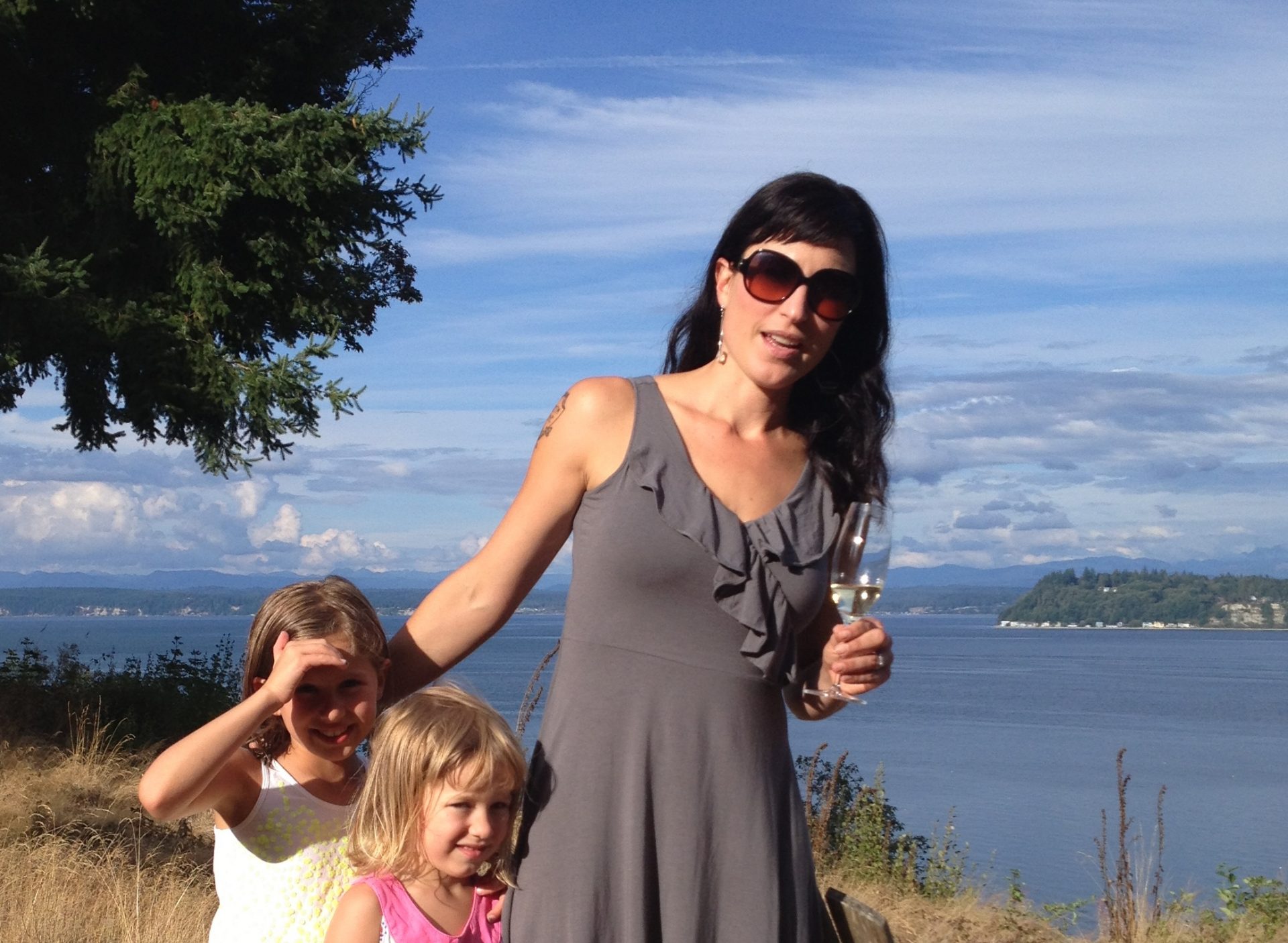

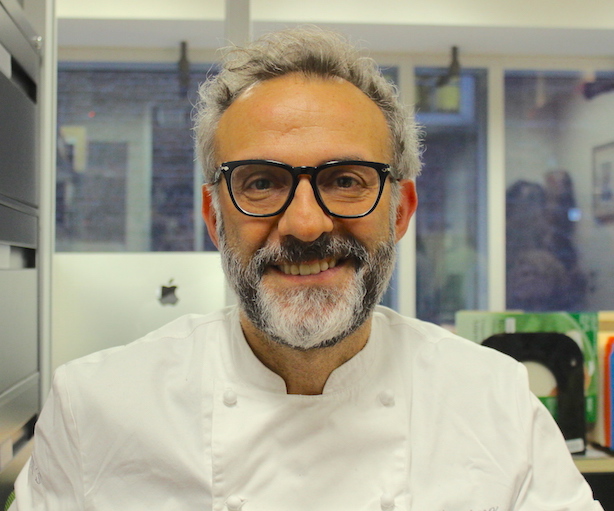
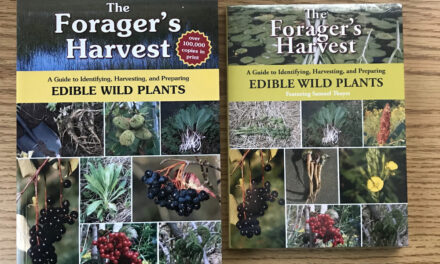

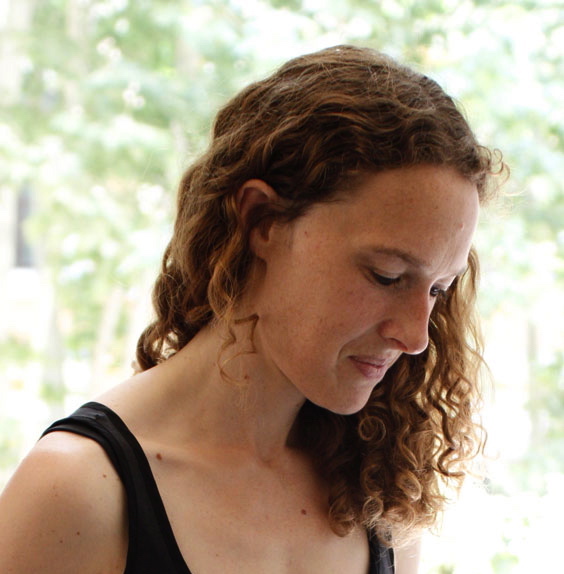

Trackbacks/Pingbacks